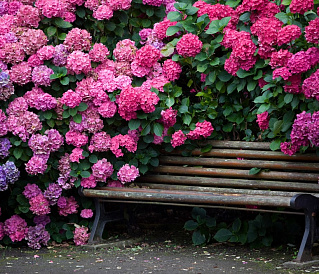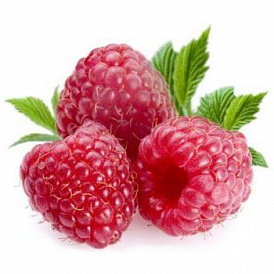14 best varieties of sweet cherry
Experts of the online magazine EXPERTOLOGY have done a great job of identifying popular and interesting sweet cherry varieties and, based on the description and opinion of summer residents, ranked the most successful breeding representatives of the berry family from different ripening periods.
Rating of the best varieties of sweet cherry
| Nomination | a place | sweet cherry variety | price |
| The best early varieties of sweet cherry | 1 | Iput | 900 ₽ |
| 2 | Leningrad black | 900 ₽ | |
| 3 | Chermashnaya | 900 ₽ | |
| 4 | Backyard Yellow | 350 ₽ | |
| 5 | Sadko | 1500 ₽ | |
| The best mid-season varieties of sweet cherry | 1 | Fatezh | 1500 ₽ |
| 2 | Folk Syubarova | 900 ₽ | |
| 3 | Oryol pink | 480 ₽ | |
| 4 | Gift to Stepanov | 480 ₽ | |
| The best late varieties of sweet cherries | 1 | Revna | 760 ₽ |
| 2 | Large fruit | 900 ₽ | |
| 3 | Large-fruited Tyutchevka | 1500 ₽ | |
| 4 | Bryansk Pink | 480 ₽ | |
| 5 | Michurinka (Michurinskaya late) | 760 ₽ |
The best early varieties of sweet cherry
In the first summer month, an early variety of trees will be awarded with a cherry crop.
Iput
Rating: 4.9
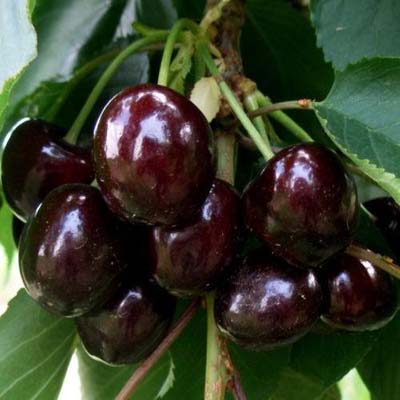
The leader of the rating of early ripe varieties of large, bulk cherries Iput, carrying winter frosts. The tree is drawn up to 6 meters, therefore it is necessary to maintain a distance of at least 3 meters between the plants in the garden. Up to 35 kg of a rich dark burgundy shade, each weighing 5 ... 10 grams, can be harvested from a wide and abundant crown in a productive year. The juicy soft body of the berries is moderately dense and pleasant organoleptic characteristics with slightly perceptible sourness, which is enhanced in the absence of a sufficient amount of insolation and a comfortable summer temperature.
The path is demanding of the sun, but it also tolerates frosts, it takes root in various weather-affected areas of the central belt and the Ural range. However, severe frosts can damage young twigs and buds, flower stalks, as well as the April frosts in May - the death of entangled buds reaches 60%. Grade when breeding graft resistance to common parasites and viruses.
In the best way, Iput pollinated cherry varieties Ovstuzhenka, Raditsa, Bryansk Rose, Revna, Tyutchevka.
Virtues
- Adaptability to winter cold;
- Large berries with decent taste;
- Parasites variety does not hit.
disadvantages
- Abundance of precipitation leads to supersaturation and bursting of fruits;
- Damage to May low temperatures (the problem of early varieties).
Leningrad black
Rating: 4.8
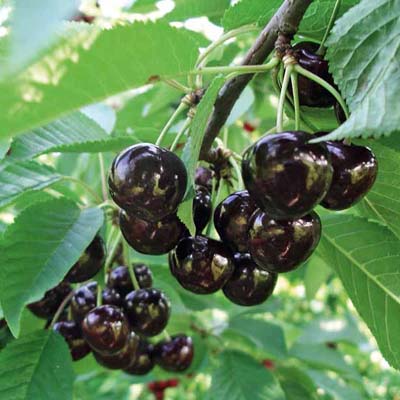
The Cherry tree of the Leningradskaya variety is pulled up to 6 meters and bears fruit only three years after settling for permanent residence, developing small berries up to 5 gr. with a delicate sugar taste with a light sourness, and at full ripeness also with a slight bitterness, estimated at 4.2 out of 5 points. This led the representative to the second place ranking.
The Leningradskaya black tree gives not only tasty berries, it is undemanding in its care and is quite resistant to common parasites. Good resistance to -300With frost.
The weak spot is the high summer humidity and excess water, leading to rupture of the shell of the berries. The variety will give fruit in the "friendship" with representatives of the varieties Leningradskaya yellow, Leningradskaya pink, Red dense, Fatezh.
Virtues
- Moderate taste of berries;
- No frost damage;
- Quick survival rate and fast fruiting.
disadvantages
- The need for pollinators of certain varieties;
- Weakness to excess water.
Chermashnaya
Rating: 4.7
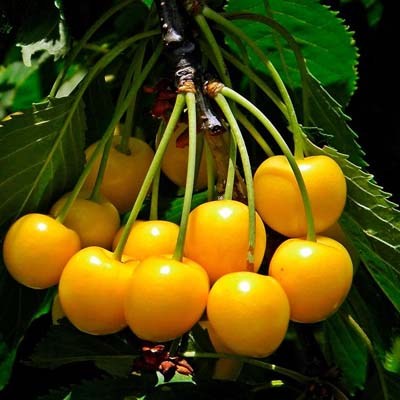
Chermashnaya berry has an unusual yellow color, slightly whitened. The tree stretches up to 5 meters, but the spherical crown is not polluted, the sun fully illuminates and warms each twig, so the berries are rich and sweet with a slight tinge of sourness, weighing up to 4.5 grams. By the way, they ripen non-simultaneously, so the harvest can be enjoyed for a week or two. In total, a fully formed tree will reward the host with 20 kilograms of sweet cherries.
When settling a sapling on a plot, the summer resident can be sure: in 3-4 summer you can enjoy the first berries, but for this, the plot should have a neighborhood of a tree with the “relatives” of the Fatezh, Raditsa and Bryansk pink varieties. Chermashnaya feels great in warm regions, on the terrain with frosts there is a low tolerance even nesurovye cold.
Virtues
- The dessert taste of the berries is medium-sized;
- Excellent survival rate;
- Strong immunity.
disadvantages
- Non-simultaneous ripeness of berries;
- Inability to develop normally in the northern regions.
Backyard Yellow
Rating: 4.6
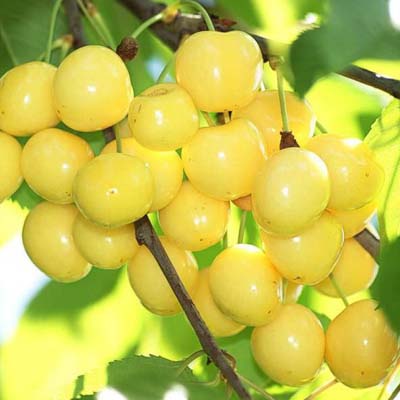
The third place is taken by another representative of the sweet varietal Garden Yellow, from the name of which the color of the berries is clear. True, in comparison with Chermashnaya, the fruits are brighter golden, but small (5.5 gr.), Ideal for taking immediately after assembly - very sugar with a minimal hint of acidity. Abundant fructification - 22 tons per hectare.
The tree does not stretch more than 5 meters, it is characterized by accelerated growth, but the fruiting will have to wait about 6 years. But this cherry is not needed pollinators - an undoubted advantage. Another argument is adaptability to the fads of winter and a high degree of preservation of fruitful buds in the spring.
Virtues
- Ovaries persist in April-May frosts and winter cold;
- Appetizing fruits;
- No need for pollinators;
- Berries do not crumble;
- Convenient collection - berries grow on the branch often.
disadvantages
- Intensive growth (growing, need to be molded);
- Long waiting for fruiting.
Sadko
Rating: 4.5
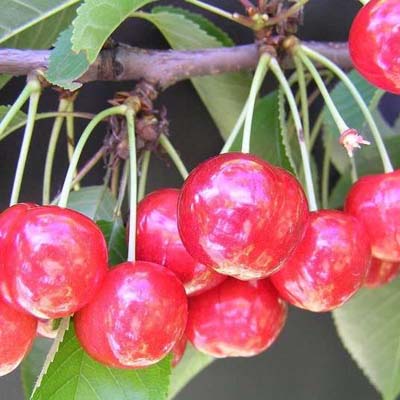
Sadko cherries of the variety Sadko with a crown of medium spreading give very large berries - their weight is maximum in the early-ripening category and reaches 6.1 ... 8.1 gr., The color is rich dark red, and the taste is surprisingly sweet with a high rating of 4.7. It is noteworthy: the pulp is easily separated from the small bone, the juicy body does not crack from excess moisture.
The tree grows moderately, you can expect a harvest by the fourth year, but on condition of neighborhood with other varieties. Sadko should be protected from coccomycosis, it will cope with other diseases on its own.
Virtues
- Large fruits with dry branch of the stem;
- Dessert fruits that are easy to peel;
- Resistance to winter cold.
disadvantages
- The average resistance to coccomycosis;
- Pollination is required.
The best mid-season varieties of sweet cherry
Want to treat yourself to cherries at the beginning - mid-July, purchase seedlings of mid-season varieties. And we will tell you how gardeners prefer.
Fatezh
Rating: 4.9
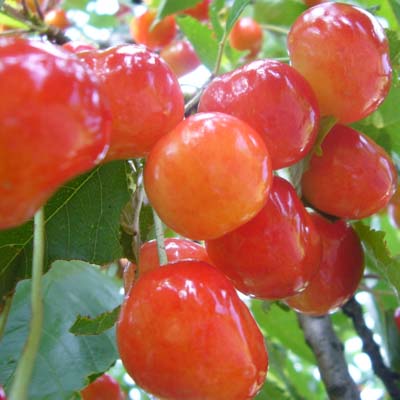
The second half of July is rich in the sweet cherry yield of the leading Fatezh variety, from a developed tree half a centner of fruit is harvested, at the beginning of fruiting from 10 kg.The tree does not extend more than 5 meters, while its branches are spreading, and the crown resembles a ball that needs molding. Particular attention should be paid to the lower branches: they are the most loaded with fruits and bend under the weight.
The berries will delight any gourmet and summer resident - they are juicy and very sweet, the bone can be easily removed, leaving a pink dense flesh. The size of the fruit is determined by different factors: in warm and sunny summer with sufficient watering and nutrient soil, they reach a weight of 6 grams, with a deficit of one of the factors, a decrease in weight to 3.8 grams.
To Fatezh pleased with the berries, you should plant it in the Central region next to Chermashna, Ovtsuzhenka, Iputu, Raditsa or Revna.
Virtues
- Amazing taste with almost imperceptible sourness;
- Excellent winter hardiness;
- Immunity to disease;
- Juicy pulp with a simple separation of the bone.
disadvantages
- Fruit size is not stable;
- It is necessary to form an expanding crown.
Folk Syubarova
Rating: 4.8
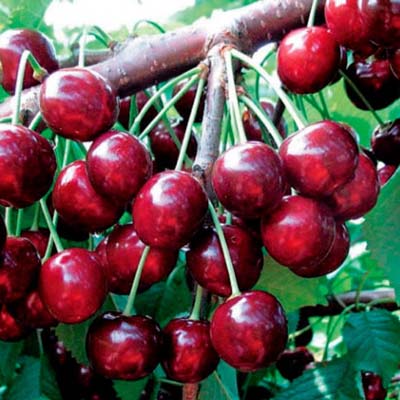
This samoplodnaya sweet cherry surely takes the second place of a rating of mid-season berries according to expert.bigbadmole.com/en/en/. Folk Syubarova is well accustomed and develops in many regions due to its excellent frost resistance and, which is not typical of the species, to the winds. Foliage and fruits are also not afraid of sunburn, parasites.
Berry pickings are held by the end of July, ripe berries are removed in weight of 6 grams, and they taste traditional sweet-sour. An adult tree is able to produce up to 50 kg of cherries, which is possible already for 6 years of development.
Virtues
- Unpretentiousness to the conditions of growth and development;
- Can grow in windy terrain;
- The classic taste of berries;
- May be used in a tapeworm or fruit tree;
- Abundant fruiting.
disadvantages
- Does not tolerate stagnant moisture in the soil.
Oryol pink
Rating: 4.7
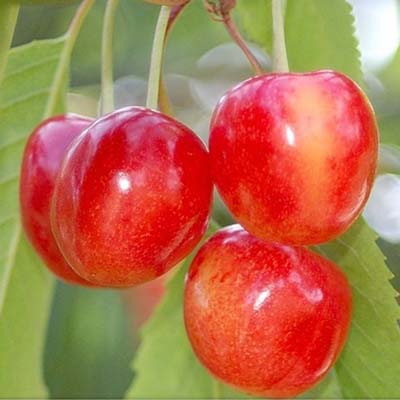
At first glance it may seem that the berry is unripe, but for Oryol pink a reddish red with light spots is a natural color. Fruits grow on a stunted tree, the height of which even in adulthood does not exceed 3 meters - this greatly facilitates the harvesting process, which comes to mid-July. It is noteworthy that you can count on a return from a young tree in the third year of development. Requires the participation of pollinators.
The berries themselves are small, their weight does not exceed 4 grams, the separation of the small stone is uncomplicated. Orlovskaya pink cherry is defined to dessert varieties and is good unprocessed; it is also suitable for canning, but it is used infrequently.
The picture of advantages is saddened by the average resistance to pests - observation and timely treatment of coccomycosis and moniliosis is necessary.
Virtues
- Dessert destination berries;
- Low tree;
- The unusual color of the fruit;
- Ability to give berries in the third year of development.
disadvantages
- The berries are small in size;
- Insufficient immunity.
Gift to Stepanov
Rating: 4.6
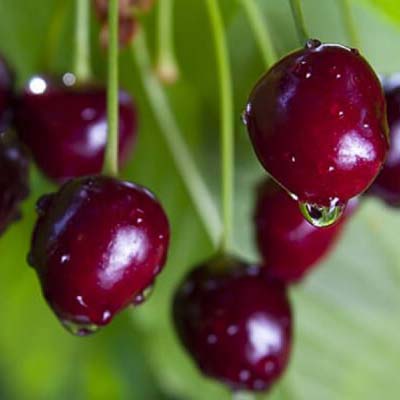
This relatively young variety is selected from the Bryansk cherry tree, it has absorbed all the best from the “progenitor”: height up to 5 meters, medium-sized berries up to 4.5 grams. with elastic sugary pulp (4.9-5.0 b.) of intense maroon-black color. Gardeners are happy with their productivity, especially in central and southern regions - the tree is not afraid of drought (but the young plant requires watering at least once a week) and coolness, it winters well and resists pests.
For fruiting, Teremoshka and Lyubimitsa Astakhova varieties are recommended for the neighborhood.
Virtues
- The most delicious cherry variety according to gourmets and experts;
- Uncomplicated detachable bone and stalk;
- Good immunity.
disadvantages
- Small berries with medium bone size.
The best late varieties of sweet cherries
The main advantage of sweet cherry varieties ripening by August is to minimize the risk of kidney damage by spring frosts, so picking berries at the end of summer is usually the richest.
Revna
Rating: 4.9
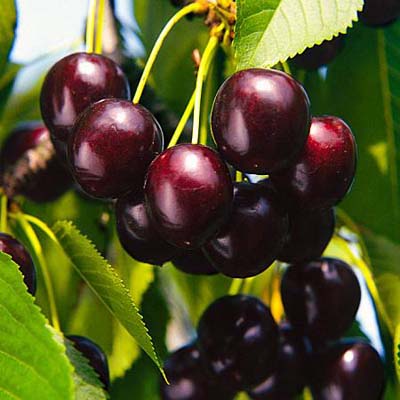
Up to 30 kg of large (up to 8 grams) dark red and incredibly tasty berries, rated by the highest score (4.8 ... 5.0), can develop simultaneously at an average height of an adult cherry tree in a sparse crown. The tree is partially able to pollinate itself, but only by 5%, so the neighbors by grade do not interfere (Iput, Ovstuzhenka, Raditsa, Tyutchevka). The crown grows intensively, so it needs to be molded, since the tree allows it to be done.
Freezers almost do not hit the tree, it tolerates the fads of mid-winter winters, as well as the returning spring cold. Immunity to diseases sure, so the parasites of sweet cherry are not terrible.
Virtues
- Large, highly valued berries;
- Resistance of a tree and young escapes to frosts, including spring;
- Berries do not crack with an excess of water;
- Persistent immunity.
disadvantages
- The plant begins to give fruit only in 5 years;
- Looking for "neighbors" - pollinators.
Large fruit
Rating: 4.8
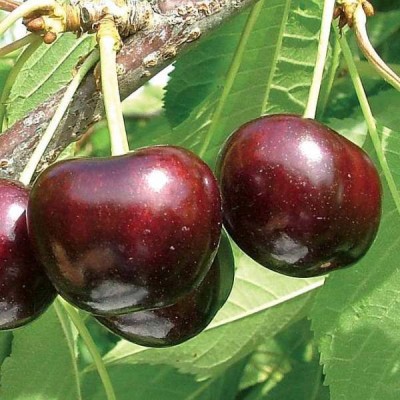
The name of the variety speaks for itself: the berries of the cherry are large, much more weighty than the rest - up to 14 grams, or even 18 grams. Fruits of a deep dark color, all of the same shape, smooth and neat, sweet-sour to taste, suitable for transportation. Bones and peduncles come off easily - before use, it is easy to clean, including large amounts of preservation.
The plant stretches up to 5 meters, its crown is scattered widely - for order it is recommended to give it shape. Near to grow other varieties of sweet cherry varieties for large-fruited pollination. The adult bush will please with abundant offspring - up to 56 kg.
Virtues
- Excellent frost resistance;
- The largest of these fruits;
- Good taste;
- Drought does not affect the taste of the berries;
- Immunity to characteristic ailments.
disadvantages
- Molding required;
- Do not do without pollinating "neighbors" (Bugaro Oratovsky, Surprise, Francis).
Large-fruited Tyutchevka
Rating: 4.7
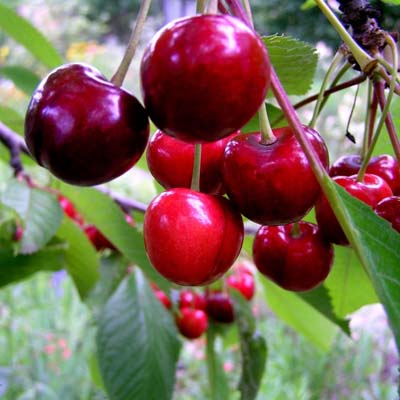
By the end of the second summer month, one can feast on Tyutchev's cherry (Tyutchevka Krupnoplodnoy). This is the optimal size of berries up to 7-8 gr., Intense red with a slightly noticeable speck. The difficulty will cause the removal of the bone from the soft body, but the fruit stem is removed dry. Gourmets and sweet tooths will appreciate the Cherry Big Tonya Tyutchevka: it is sugary with moderate intrinsic acidity.
One tree can give about 40 kg of berries - not the most impressive, but the best result for sweet cherries. For the buds to start, an additional tree - pollinator will be needed, although the variety Krupnoplodnaya Tyutchevka is capable of partial self-pollination.
A rainy summer will turn into a nuisance - the berries will crack. It is also dangerous to defeat coccomycosis and nodulation, moniliasis. The winter frosts of the tree are not scary, but the spring can destroy more than 65% of the ovaries.
Tyutchevka bred for breeding in the central zone, is well acclimatized in the south of the Urals.
Virtues
- Great sugar flavor;
- Stable rich yield;
- Portability winters middle band.
disadvantages
- Affected by disease, prevention is needed;
- Violation of the integrity of the berries during waterlogging;
- Difficult pulp removal.
Bryansk Pink
Rating: 4.6
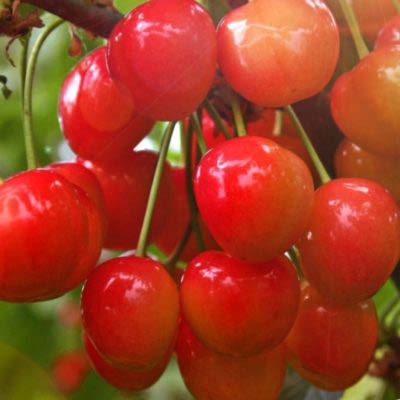
A widespread variety of August ripeness, Bryansk Rose is a tree of short stature up to 4 meters, a crown neat with moderate branching. Berries, as the name implies, are pink, with a noticeable speck, small (up to 5.5 grams), resistant to excess water. The bone, though small, but its separation from the pulp somewhat difficult. There is no sour taste, it is replaced by a slight bitterness against the background of unsurpassed sweetness. This property is used in conservation and in winemaking.
In order for an adult tree to give 20 ... 30 kg of fruits, beside or by grafting, it is necessary to use another type of cherry.
Bryansk Pink is resistant to frosts and diseases, the variety is bred for distribution in the Central regions and in the middle lane.
Virtues
- Berries do not crack;
- Immunity to disease and cold;
- No sour taste.
disadvantages
- Difficult separation of the bone;
- Ovaries are afraid of spring frosts;
- Medium-sized berries.
Michurinka (Michurinskaya late)
Rating: 4.5
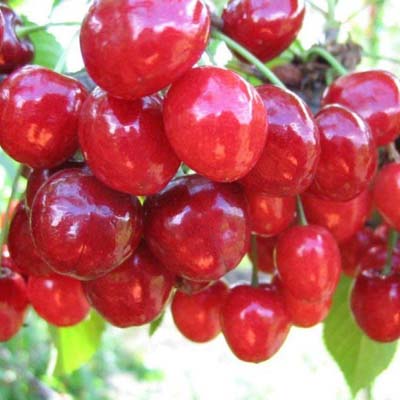
The rating is completed by a late ripening Michurinskaya cherry variety with berries of a rich dark red color and small size (weight up to 6.5 grams). Fruits have a characteristic abdominal seam and a pronounced juicy sweet taste. The stone is easily separated, as is the stem.
The tree grows quickly, an accurate raised crown is formed, it tolerates winter frosts well, as well as drought, it begins to bear fruit in the fifth year, needs pollinators. The plant is not afraid of disease.
Michurinka fruits regularly, yields up to 140 centners per hectare under conditions of Michurinsk and its region, feels good in the same climatic zone.
Virtues
- Resistance to winter cold;
- Resistance to transportation;
- High and regular yield;
- Rated taste.
disadvantages
- With significant frosts, the longevity of the tree is reduced.
Attention! This rating is subjective, is not advertising and does not serve as a guide to the purchase. Before buying, you should consult with a specialist.



